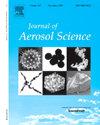Screen diffusion battery method for measuring the size distribution of radioactive aerosol employing multi-layer perception (MLP) neural network
IF 2.9
3区 环境科学与生态学
Q2 ENGINEERING, CHEMICAL
引用次数: 0
Abstract
The precise characterization of the size distribution of radioactive aerosol particles is essential for environmental radiation protection. The screen diffusion battery (SDB) method has been extensively utilized for the sizing of radioactive aerosols. Nevertheless, the accurate and rapid inversion remains a significant challenge within this methodology. This study proposes several multilayer perceptron neural network models to tackle this issue. The performance and applicability of models were assessed using simulated and laboratory measurement data. Results showed that the model achieved accuracy of above 89 % at the error noise level of 10 % in the peak shape classification task. For unimodal distribution parameters, the MAPE (Mean Absolute Percentage Error) of AMD (Activity Median Diameter) and (GSD, Geometric Standard Deviation) were maintained below 1.5 % and 3.4 % at noise level of 10 %. For bimodal distribution parameters, the MAPE of all parameters were below 10.5 % at noise of 10 %. These results demonstrate the model's exceptional predictive accuracy and robust noise immunity. Comparison results in radon chamber showed a good linear correlation between AMD (obtained by the SDB system using MLP) and CMD (Count Median Diameter, measured by SMPS) with R2 of 0.888, verifying the practical measurement capability of MLP method. The prediction results can be generated almost instantaneously in the millisecond range, which presents potential for real-time and large-scale measurements. Moreover, compared with the conventional method, this MLP method does not require manual selection of initial iteration parameters and will not produce unstable oscillating solutions. These findings can significantly enhance the efficiency and reliability of radioactive aerosol size distribution analysis, supporting improved environmental monitoring, radiation risk assessment and safety protocols in nuclear facilities.
采用多层感知(MLP)神经网络测量放射性气溶胶尺寸分布的屏幕扩散电池方法
准确表征放射性气溶胶粒子的大小分布对环境辐射防护至关重要。筛网扩散电池(SDB)方法已被广泛应用于放射性气溶胶的分级。然而,准确和快速的反演仍然是该方法的一个重大挑战。本研究提出了几个多层感知器神经网络模型来解决这个问题。利用模拟和实验室测量数据对模型的性能和适用性进行了评估。结果表明,该模型在峰形分类任务中,在误差噪声水平为10%的情况下,准确率达到89%以上。对于单峰分布参数,在噪声水平为10%时,AMD(活动中位直径)和σg(几何标准差)的MAPE(平均绝对百分比误差)分别保持在1.5%和3.4%以下。对于双峰分布参数,在噪声为10%时,所有参数的MAPE均小于10.5%。结果表明,该模型具有良好的预测精度和抗噪声能力。氡室对比结果显示,用MLP法测定的SDB系统得到的AMD与用SMPS法测定的CMD呈良好的线性相关,R2为0.888,验证了MLP法测量的实用能力。预测结果几乎可以在毫秒范围内立即生成,这为实时和大规模测量提供了潜力。此外,与传统方法相比,该方法不需要人工选择初始迭代参数,不会产生不稳定的振荡解。这些发现可以显著提高放射性气溶胶粒径分布分析的效率和可靠性,为改进核设施的环境监测、辐射风险评估和安全规程提供支持。
本文章由计算机程序翻译,如有差异,请以英文原文为准。
求助全文
约1分钟内获得全文
求助全文
来源期刊

Journal of Aerosol Science
环境科学-工程:化工
CiteScore
8.80
自引率
8.90%
发文量
127
审稿时长
35 days
期刊介绍:
Founded in 1970, the Journal of Aerosol Science considers itself the prime vehicle for the publication of original work as well as reviews related to fundamental and applied aerosol research, as well as aerosol instrumentation. Its content is directed at scientists working in engineering disciplines, as well as physics, chemistry, and environmental sciences.
The editors welcome submissions of papers describing recent experimental, numerical, and theoretical research related to the following topics:
1. Fundamental Aerosol Science.
2. Applied Aerosol Science.
3. Instrumentation & Measurement Methods.
 求助内容:
求助内容: 应助结果提醒方式:
应助结果提醒方式:


